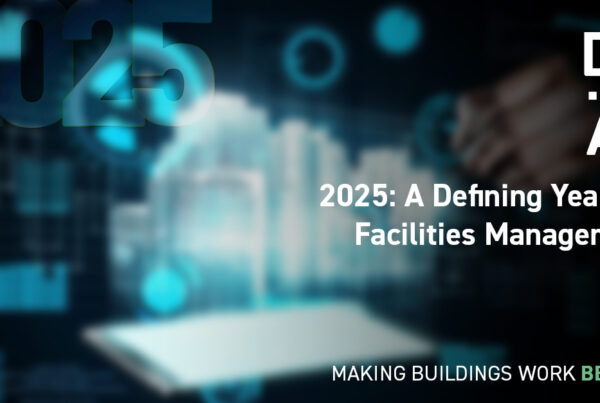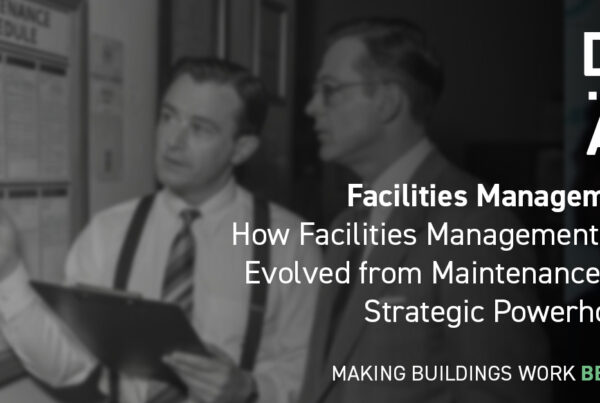
Predictive Maintenance: How Data and AI Are Transforming Facilities Management
Maintaining the smooth operation of modern buildings is an increasingly complex responsibility. Across the United Kingdom, public and private buildings alike face mounting challenges, reflected most starkly in the staggering £49 billion maintenance backlog reported across public services.
This backlog is not merely an accounting figure; it signals an urgent need for change. Inadequate maintenance practices, ageing infrastructure, and underinvestment are leaving critical systems vulnerable to failure when they are needed most. We believe that the traditional approaches to maintenance are no longer sufficient to meet today’s demands. The future of effective maintenance lies in embracing data-driven strategies and integrating artificial intelligence (AI) to predict and prevent problems before they escalate.
Moving Beyond Traditional Preventative and Reactive Maintenance Approaches
Historically, critical building systems have been managed through either preventive or reactive maintenance. Preventive maintenance involves scheduled inspections and servicing at set intervals, regardless of whether a fault has been detected. This approach aims to reduce the risk of breakdowns, but without the support of data, it can lead to unnecessary work and wasted resources.
Reactive maintenance, on the other hand, involves responding to breakdowns as they occur. Although it may appear cost-effective in the short term, this approach can be inefficient and risky. Unplanned repairs often come with higher costs, shorter equipment life spans, and operational disruptions that can seriously affect building occupants. In sensitive environments such as hospitals or schools, system failures can go beyond inconvenience, potentially endangering patient care or disrupting educational activities.
For these reasons, it is becoming increasingly clear that a shift toward predictive maintenance is essential for modern building management.
Understanding Predictive Maintenance
Predictive maintenance relies on real-time data and advanced analytics to monitor equipment performance and detect early signs of wear or failure. Instead of following fixed schedules or waiting for systems to fail, predictive maintenance uses smart sensors, connected devices, and AI-powered tools to assess the condition of assets continuously.
Facilities management teams can then:
- Identify small issues before they become costly failures
- Optimise equipment performance to extend its life span
- Reduce energy consumption and improve sustainability outcomes
- Maintain smooth operations with fewer unexpected interruptions
This data-led approach focuses on applying the right maintenance interventions at the right time, ensuring that resources are used efficiently and effectively.
Proven Results in Practice
DMA Group are not only advocates for predictive maintenance; we are practitioners. Over the past eight years, we have developed and refined our own award-winning workforce and resource management platform, BiO®.
BiO® has allowed us to transform how we deliver maintenance services by automating workflows, streamlining communication, and providing transparent, real-time operational data to our customers. With BiO®, we have doubled our business efficiency and saved over 12,000 hours of previously unproductive time each year. Importantly, this system empowers both our team and our customers by offering live access to performance dashboards at any time, from any device.
Through this integrated platform, we have been able to shift our focus from reactive problem-solving to proactive performance management, delivering better outcomes for our customers and their buildings.
The Critical Role of Artificial Intelligence
Artificial intelligence serves as the analytical engine behind predictive maintenance. By processing vast amounts of data from sensors, meters, and building management systems, AI can identify hidden patterns, detect anomalies, and improve prediction models over time.
This capability means that facilities management teams no longer need to rely on guesswork or wait for service disruptions to act. AI can highlight where risks exist, recommend targeted interventions, and continuously learn from historical and real-time data to refine its predictions.
In addition to improving asset management, AI also enhances workforce allocation. By prioritising high-risk issues and suggesting the most efficient use of engineering resources, AI helps ensure that attention is focused where it is needed most. Over time, predictive models become more accurate and effective, contributing to a virtuous cycle of improvement.
Navigating the Challenges of Predictive Maintenance
Although the benefits of predictive maintenance are clear, implementing this approach is not without its challenges. Many buildings still rely on legacy systems that are not designed to integrate with modern analytics or AI tools, requiring investment in system upgrades. Budget constraints can further limit proactive investment, especially in sectors where reactive maintenance has historically been the default approach.
Moreover, predictive maintenance depends on the availability of high-quality data. Incomplete or fragmented records can undermine the accuracy of predictive models, making data management a critical success factor. Finally, organisations must invest in upskilling their teams to ensure that staff can effectively work alongside new technologies, interpret insights, and apply them to practical decision-making.
Best Practices for Moving Forward
To navigate these challenges successfully, we recommend that facilities and building management teams take a structured, thoughtful approach to adopting predictive maintenance.
- Define the problems to solve. It is essential to avoid adopting technology for its own sake. Clear leadership and stakeholder engagement can help identify the most pressing operational challenges and ensure that solutions are aligned with strategic priorities.
- Assess current systems. Understanding the capabilities and limitations of existing infrastructure is key to planning upgrades and integrating new tools effectively.
- Start small and scale thoughtfully. Pilot programmes can provide valuable insights into what works, allowing organisations to test solutions on a manageable scale before wider implementation.
- Invest in training and development. Equipping teams with the knowledge and skills to work effectively with data and AI tools is vital for long-term success.
- Focus on continuous improvement. Predictive models must be regularly reviewed and refined based on feedback and results to ensure ongoing accuracy and value.
- Prioritise data quality. High-quality, consistent data is the foundation for effective predictive maintenance. Without it, even the most advanced tools will fall short.
Building a Smarter and More Sustainable Future
The adoption of predictive maintenance is not simply about cutting costs, although it does deliver significant financial savings. It is about creating safer, more reliable, and more sustainable buildings. By combining data-driven insights, AI-powered analytics, and human expertise, facilities teams can extend the life spans of assets, reduce carbon footprints, and enhance the resilience of the built environment.
DMA are committed to helping our customers embrace these innovations and realise their full potential. Predictive maintenance, supported by AI and real-time data, represents a powerful opportunity to future-proof building operations and navigate the challenges of a rapidly evolving sector.
If your organisation is ready to explore how data-driven strategies can improve maintenance outcomes and deliver long-term value, we invite you to connect with our team. Together, we can unlock the benefits of predictive maintenance and help ensure that your buildings continue to support the people and communities that rely on them.




